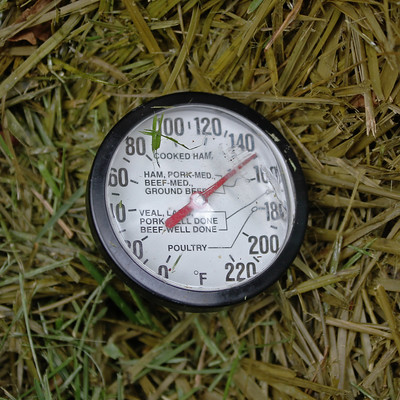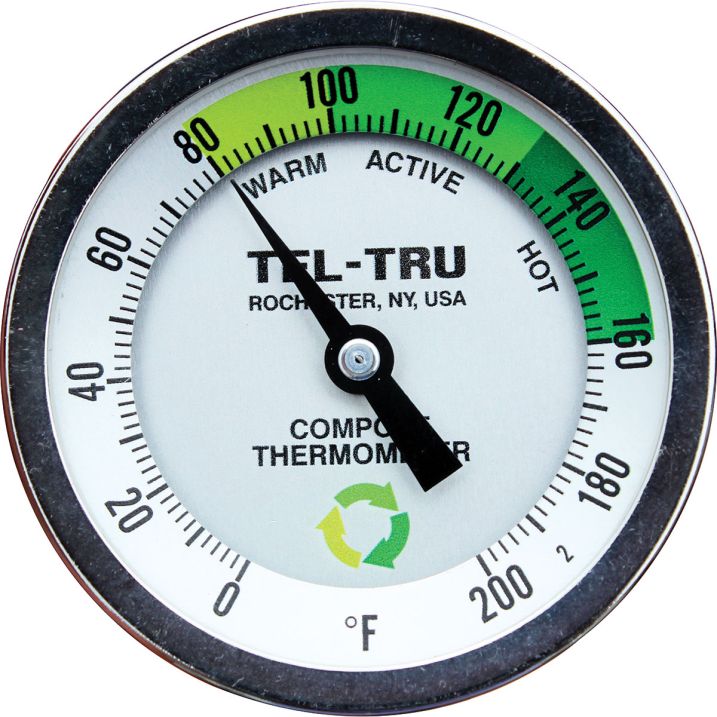Compost is a biological marvel that turns organic waste into nutrient-rich soil. It’s a form of recycling that reduces landfill waste and enhances the quality of our soil. Central to this miraculous transformation is compost temperature control. Compost temperature is not merely a casual aspect but is instrumental to the successful execution of composting. It impacts the speed of the composting process, the type of microbes involved, and the quality of the final product. This article explores the importance of maintaining compost temperature in piles and bins.
Importance of Proper Compost Temperature Control
Proper temperature control is a linchpin in the successful creation of compost. It’s not just about a collection of kitchen scraps, yard waste, and time. Instead, successful composting hinges on understanding and maintaining the right temperature to support a thriving microbial ecosystem, optimize decomposition, and create rich, nutrient-filled compost for your garden.
Composting is, in essence, controlled decomposition facilitated by bacteria, worms, fungi, and other organisms. These compost dwellers are categorized into mesophilic organisms, which thrive at moderate temperatures, and thermophilic organisms, which prefer high temperatures. Each group has a crucial role at different composting stages, making temperature control a key aspect of composting.
When a compost pile is built, mesophilic organisms are the first to break down the organic material, gradually raising the temperature to about 110 degrees Fahrenheit. Following this, thermophilic organisms take over, rapidly breaking down complex materials like proteins, fats, and cellulose, taking the compost pile temperature between 130 and 160 degrees Fahrenheit.
In this temperature range, composting occurs faster, and most weed seeds and plant diseases are killed, making the finished compost safer for use in the garden. Hence, maintaining this ideal temperature range becomes crucial to successful composting.
However, temperatures beyond 160 degrees Fahrenheit can prove detrimental. It can kill off beneficial microorganisms and slow decomposition, leading to unpleasant odors.
To manage the compost temperature, regular turning and moisture control are essential. Turning the compost pile allows for better aeration, preventing the compost from becoming anaerobic and, therefore, smelly. It also helps redistribute the heat, allowing the compost to cool down if it’s too hot and heat up if it’s too cold. Maintaining optimal moisture levels is also crucial, as both overly dry or overly wet conditions can impede the composting process.
Proper compost temperature control is crucial to optimize the composting process, ensuring faster decomposition and yielding a higher quality, nutrient-rich compost. Paying attention to your compost temperature can effectively support the microbial life that fuels composting, creating a healthier, more productive garden environment.
The Role of Temperature in Composting
When you create a compost pile, you’re setting up a habitat for millions of microorganisms, mainly bacteria and fungi. These tiny composting allies feed on the organic matter in the compost pile and, in the process, generate heat. This is why temperature plays such a crucial role in composting.
There are three main temperature stages in the composting process, each stage hosting different types of microorganisms:
- Mesophilic Phase (50-104°F or 10-40°C): The process begins with mesophilic microorganisms that start breaking down the soluble, readily degradable compounds. This stage is usually brief and leads to an increase in temperature.
- Thermophilic Phase (105-160°F or 40-70°C): As the temperature rises, thermophilic microorganisms take over. Thermophilic means that they favor warm environments. These microbes can break down more complex materials, such as proteins, fats, and cellulose, which can’t be degraded at lower temperatures. This is also the most important phase in removing pathogens (diseases and other bad stuff that might be in compost.) This phase can last for several days or weeks, depending on the materials present and the conditions.
- Cooling and Maturation Phase (<104°F or <40°C): After the thermophilic phase, the compost pile gradually cools down, and mesophilic microorganisms repopulate the compost pile to continue the decomposition process, during which the compost matures and stabilizes. Below about 100 degrees, there isn’t much composting activity happening. Towards the end of the composting process, this can be fine or a sign of a stagnant compost pile.
Speed of Composting
Temperature influences the speed of composting. A higher temperature accelerates the process, provided it’s within the optimal range for the microorganisms involved. On average, a compost pile that maintains the correct temperature can turn organic waste into usable compost within two to three months.
Compost Temperature in Vermicomposting
Vermicomposting, the process of using worms to decompose organic waste, presents its own unique set of considerations when it comes to temperature control.
Just like in traditional composting, temperature plays a pivotal role in vermicomposting, largely due to its impact on the red wriggler worms typically used in the process. Unlike traditional composting, where thermophilic bacteria can heat the compost pile to between 130 and 160 degrees Fahrenheit, vermicomposting requires a much cooler environment. Red wriggler worms prefer temperatures between 55 and 77 degrees Fahrenheit, so maintaining compost piles within this range is crucial for optimum worm health and productivity.
Vermicomposting generates less heat than traditional composting, as worms are the primary agents of decomposition rather than heat-loving bacteria. However, it’s still essential to monitor the compost pile temperature. Excessive heat can create an inhospitable environment for the worms, possibly leading to their death (or them just leaving), while overly cool temperatures can slow down their activity and reproduction, thus slowing the composting process.

To maintain the compost pile within the worm-friendly temperature range, use these same techniques for careful management of the composting materials. The ratio of green to brown materials should be balanced, as too much green (nitrogen-rich) material can cause overheating. Compost bins or piles should be kept in areas with moderate ambient temperatures and out of direct sunlight to prevent overheating.
Additionally, in colder months, insulating your compost bin or moving it to a warmer location may be necessary to protect worms from freezing temperatures. Proper moisture control is also vital, as a well-moisturized pile can help maintain a stable temperature environment.
While vermicomposting operates at lower temperatures than traditional composting, maintaining an appropriate temperature range is just as important. Through careful compost pile management, you can create an environment conducive to worm activity, accelerating decomposition and generating nutrient-rich compost beneficial to your garden’s health.
Pathogen and Weed Seed Destruction
Proper temperature control is critical for sanitizing compost. Most pathogens and weed seeds are killed when exposed to temperatures between 130-160°F (55-70°C) for a sustained period. This ensures that the finished compost is safe to handle and won’t introduce diseases or weeds into your garden.
Retention of Nutrients
If the compost pile becomes too hot (>160°F or 70°C), it can kill beneficial microorganisms and lead to nutrient loss. The nitrogen in the compost may be lost as ammonia gas, reducing the nutrient value of the finished compost.

How to Measure Compost Temperature
It’s difficult to measure compost temperature without a compost thermometer. A compost thermometer can provide a more precise temperature reading than your hand, which can’t really give you precise measurements. Check the temperature at several locations and depths within the pile for accuracy.
You place the thermometer directly into your compost and measure the temperature. Many of these are mechanical thermometers, so you can leave them directly in your compost. They do have some fancier battery-powered thermometers. Those are great, too, and often have significant battery storage so they can be left in the compost.
However, a stagnant or slow compost pile can be a good indicator that something may be off with your compost temperature.
How to Maintain Proper Temperature in a Compost Pile
Aim for a temperature range of 105-160°F (40-70°C) to maintain a healthy composting process. Here are some tips to help manage your compost pile’s temperature:
- Turn the Pile – Turning the compost pile will introduce oxygen and even out moisture, which helps to cool the compost pile if it gets too hot and reinvigorates microbial activity if it gets too cool. It helps to ensure a more uniform compost pile. Read More
- Balance Green and Brown Material: A balanced mix of green (nitrogen-rich) and brown (carbon-rich) material will provide a balanced diet for the microorganisms and help maintain an optimal temperature. Read More
- Check Moisture Levels: Microbial activity also depends on moisture. Moisture is also critical in distributing the temperature throughout your compost pile. The compost pile should have the dampness of a wrung-out sponge. If it’s too dry, microbial activity will slow; if it’s too wet, it can lead to anaerobic conditions and odor problems. Read More

Fixing Compost Temperature Problems – How to Raise (or Lower) Compost Temperature
These same steps are used to fix compost temperature problems. You may need to pay a bit more attention when you know that you have compost temperature issues. For example, you may need to add more brown material over several days (turning each time) until your compost pile reaches the right temperature.
The big lesson with composting is patience. It’s not a fast process and may take some time to correct.
Frequently Asked Questions
What Temperature Should Compost Be?
Compost should ideally be between about 130-160 degrees Fahrenheit. Much below this temperature and the bacteria will work more slowly. Your compost also may not kill off any seeds or any diseases in the pile.
Above this temperature and the bacteria will start to die.
The ideal temperature is about 150 degrees fahrenheit, though the temperature will vary based on a number of considerations.
Where Can I Find a Good Compost Thermometer?
Amazon has a number of compost thermometers that are very affordable and easy to use. Most garden supply stores would also have them.
How Fast Does a Compost Pile Heat Up?
The process can usually happen within a few days. For example, a decent indoor system can heat up 40-50 degrees C in 2-3 days.
Can a Compost Pile Spontaneously Combust?
It’s rare, but yes it can! (Don’t worry). If it heats up quickly and there is a lot of dry material, especially without enough moisture, the brown material can catch fire.
